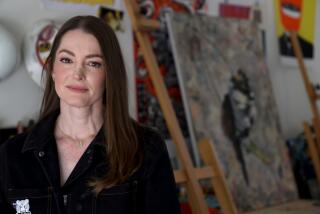Cost-Conscious Agencies Turn to Rental Photos
- Share via
The image of a lone firefighter walking into the mouth of fire is a haunting one. And anyone who looks at the highly publicized poster for the Universal Studios film “Backdraft” probably believes that the studio spent a bundle-and-half to create it.
Imagine the costs involved in setting a building on fire. Imagine renting the special fire resistant equipment worn by the firefighter. Keep imagining. That photo wasn’t taken to market the film at all. It was shot in 1978--without the firefighter--by a then free-lance photographer taking pictures of a fire in Pacific Palisades.
“I lost track of what was behind me, and I was actually surrounded by the fire,” recalls Craig Aurness, 44, whose father, James Arness, also found himself in the line of fire on the television series “Gunsmoke.” The fire photo, to which Universal eventually added its silhouette of the courageous firefighter, is now one of more than 2 million that Aurness keeps filed at his Los Angeles stock photo firm, Westlight.
Earlier this year, when Universal was preparing to market the film “Backdraft,” one phone call to Aurness’ firm turned the obscure photo into a picture seen coast to coast. With the recession prompting many companies to cut advertising costs, Universal is one of a growing number of advertisers using stock photos. One way to save on ad expenses is to rent a picture from a stock photo firm instead of sending a photographer out.
When creating ad campaigns these days, “the first thing we look at is our wallet,” said Steve Hayden, creative director at BBDO/Los Angeles.
For example, BBDO estimated that it saved thousands of dollars by using a stock photo of the San Francisco skyline for an ad for the San Francisco Convention & Visitors Bureau. Similarly, to save money, a recent United Airlines print ad includes a stock photo of Hong Kong.
Stock photos can be of just about anything: beautiful sunsets, corporate suites--or even colorful slabs of marble. To give the aura of success, many companies these days like to decorate the covers to their annual reports with images lifted from stock photos of rich marble. So hot is marble as a background that Westlight photographers have taken more than 1,000 pictures of various marble forms.
Suppliers that specialize are enjoying the most success, said Alexis Scott, publisher of the Stock Workbook. One successful firm takes photos primarily of aircraft, and another concentrates on beach scenes, she said.
The photographers who supply these photos are paid up to 50% of the fees of the photos that are rented out. The bigger the circulation of the publication that the photos appear in, the more money they fetch.
Although advertising nationwide continues to slump, many stock photo firms report that--considering the poor ad market--they’re fairing OK. Some are even seeing an uptick.
“Agencies are buying more stock photos than before, but the catch is they’re probably paying less for them,” said Marty Loken, president of Picture Agency Council of America.
“There is a gas war mentality,” said Loken, who said some stock photo firms will basically let today’s penny-pinching ad agencies name their price. Some stock pictures that several years ago rented for thousands of dollars are today going for hundreds.
“We’re all fighting for whatever money is available,” said David Kanney, president of the New York-based Image Bank. “The sweet years are past.”
For years, agency art directors mostly kept mum about using stock photos. Some still say they use them only when making new business presentations. But today, some agencies mix portions of several stock photos into a single ad--making it look like something brand new.
With stock photos, however, is always the risk of the unknown. Just ask BBDO’s Hayden. His agency created a newspaper ad for Apple Computer in mid-May that caused plenty of red faces when it unintentionally featured a stock photo of rival IBM’s office building.
In the ad, a Macintosh computer is shown hooked up to the IBM Tower in Atlanta. The agency didn’t intentionally use the rival’s building. But the picture was among the selection of stock photos sent to an unsuspecting art director who asked for pictures of office buildings.
“That’s one of the dangers of using stock photos,” Hayden said. But he insists that some good did come out of foul-up. “For years we’ve said that Macintosh is compatible with IBM,” he said. This proved it.
Being Coy Doesn’t Work
Sex still sells, but with young adults it generally works best when the advertiser is straightforward about it rather than being coy.
That is the conclusion of a new study by USC professor Michael Cody and graduate student Philip J. Lane. Their study of sexually oriented print ads found that college-age men and women are more likely to buy products in ads that frankly depict kissing or love making than in ads that rely on double-entendre or portrayals of women as sexual objects.
Briefly
Los Angeles Kings star Wayne Gretzky filmed a TV spot at Long Beach Veteran Stadium last week pitching Easton Sports hockey equipment. . . . Eight Los Angeles ad and PR agencies were duped into making wacky new business presentations last week at the Universal Hilton for an upcoming segment of the Fox TV show “Totally Hidden Video.”
More to Read
Inside the business of entertainment
The Wide Shot brings you news, analysis and insights on everything from streaming wars to production — and what it all means for the future.
You may occasionally receive promotional content from the Los Angeles Times.










